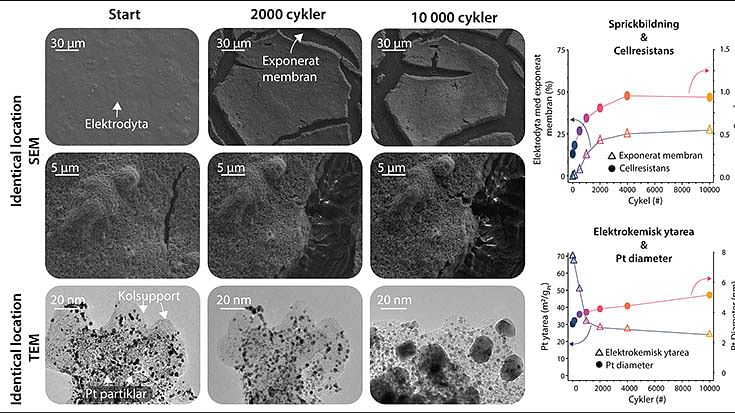Chalmers University researchers show the way for improved, longer-lasting fuel cells
Researchers at Chalmers University of Technology have developed a new experimental method for studying what affects the ageing of fuel cells by tracking a specific particle in the fuel cell during use.
More efficient and longer-lasting fuel cells are essential for fuel cell-powered heavy-duty hydrogen vehicles to be an alternative to combustion fuelled counterparts. Researchers at Chalmers University of Technology, Sweden, have developed an innovative method to study and understand how parts of fuel cells degrade over time. This is an important step towards the improved performance of fuel cells and them becoming commercially successful.
Hydrogen is a fuel alternative that is becoming increasingly interesting for heavy-duty vehicles. Hydrogen-powered vehicles only emit water vapour as exhaust, and if the hydrogen is produced using renewable energy, it is completely free of carbon dioxide emissions. Unlike battery-powered electric vehicles, hydrogen-powered vehicles do not need to burden the electricity grid, as hydrogen can be produced and stored when electricity is cheap. For some hydrogen-powered vehicles the propulsion comes from a so-called fuel cell. However, hydrogen-fuel-cell-powered vehicles are limited by a relatively short lifespan, because fuel cell components, such as electrodes and membranes, degrade over time. It is this problem that the recent study addresses.
 Using scanning electron microscopy (SEM) and transmission electron microscopy (TEM), the researchers have been able to show how the electrode degrades during use, when performing a standardised stress test.
Using scanning electron microscopy (SEM) and transmission electron microscopy (TEM), the researchers have been able to show how the electrode degrades during use, when performing a standardised stress test.
How a fuel cell works
The core of a fuel cell consists of three active layers, two electrodes – anode and cathode respectively – with an ion-conducting membrane in the middle. Each individual cell provides a voltage of about 1 volt. The electrodes contain catalyst material, and hydrogen and oxygen are added to them. The resulting electrochemical process generates clean water and electricity that can be used to power a vehicle.
Researchers at Chalmers University of Technology have developed a new method for studying what affects the ageing of fuel cells by tracking a specific particle in the fuel cell during use. The team of researchers have studied an entire fuel cell by taking it apart at regular intervals. Using advanced electron microscopes, they have then been able to follow how the cathode electrode degrades in specific areas during the cycles of use. Previous studies have been done on so-called half-cells, which are similar (but not the same as) half of a fuel-cell and are carried out under conditions that differ significantly from the real fuel cell.
Better understanding with new experimental method
"It has previously been assumed that the performance would be affected by the fuel cell being disassembled and studied in the way we have done, but it turned out that this assumption is not correct, which is surprising," says research leader Björn Wickman, Associate Professor at the Department of Physics at Chalmers.
The researchers at Chalmers have been able to explore how the material in the fuel cell degrades at both the nano and micro level, and pinpoint exactly when and where the degradation occurs. This provides valuable information for the development of new and improved fuel cells with a longer lifespan.
"From previously only looking at how the fuel cell has aged after use, we have now been able to look into the middle stage," says doctoral student Linnéa Strandberg at Chalmers. “Being able to follow a single, chosen particle within a specific area, provided a much better understanding of the degradation processes. Greater knowledge of these is an important step on the way to designing new materials for fuel cells or to adjust the control of the fuel cell.”
New method paves way for longer lasting fuel cells
The U.S. Department of Energy (DOE) has pointed out that improved lifetime of fuel cells is one of the most important goals to reach before fuel cell-powered hydrogen vehicles can become commercially successful.
"We have now laid a foundation on which to build for the development of better fuel cells. Now we know more about the processes that take place in the fuel cell and at what point over the lifetime of the fuel cell they occur. In the future, the method will be used to develop and study new materials that can give the fuel cell a longer lifespan," says Björn Wickman.
The research group at Chalmers that has developed the method consists of doctoral student Linnéa Strandberg and Associate Professor Björn Wickman, both at the Department of Physics, Victor Shokhen, former postdoc at the Department of Physics, and Magnus Skoglundh, Professor at the Department of Chemistry and Chemical Engineering.
This project was financially supported by the Swedish Foundation for Strategic Research and the Swedish Research Council and performed within the Competence Centre for Catalysis, which is hosted by Chalmers University of Technology and financially supported by the Swedish Energy Agency and the member companies Johnson Matthey, Perstorp, Powercell, Preem, Scania CV, Umicore and Volvo Group.
Scanning electron microscopy and transmission electron microscopy were performed at Chalmers Materials Analysis Laboratory (CMAL).
All images: Chalmers University of Technology
RELATED ARTICLES
Skoda begins sale of made-in-India CKD Kushaq in Vietnam
Before production started, pre-series Kushaq vehicles covered over 330,000 kilometres on a variety of Vietnamese roads a...
Six Japanese companies join forces to expand use of recycled materials in new vehicles
Denso, Toray Industries, Nomura Research Institute, Honda Motor, Matec Inc and Rever Corporation have set up the BlueReb...
BYD selects Voestalpine as steel supplier for its Hungarian plant
The announcement of the Austrian steelmaker as a supplier demonstrates BYD’s strategic plan to source from high-quality,...





 By Autocar Professional Bureau
By Autocar Professional Bureau
 15 Aug 2024
15 Aug 2024
 2147 Views
2147 Views


















